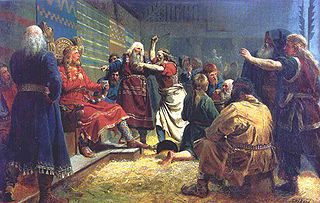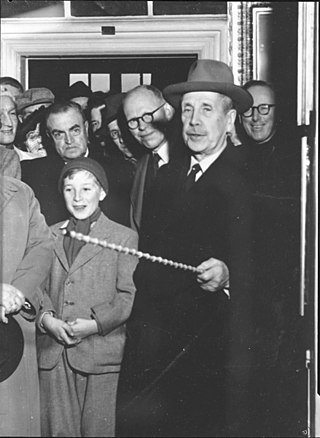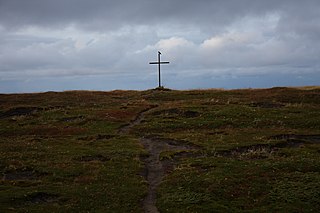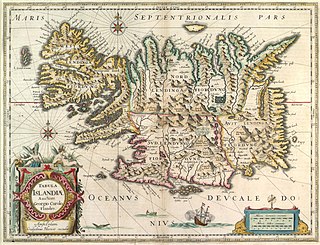
The Kalmar Union was a personal union in Scandinavia, agreed at Kalmar in Sweden as designed by widowed Queen Margaret of Norway and Sweden. From 1397 to 1523, it joined under a single monarch the three kingdoms of Denmark, Sweden, and Norway, together with Norway's overseas colonies.

Haakon Haraldsson, also Haakon the Good and Haakon Adalsteinfostre, was the king of Norway from 934 to 961. He was noted for his attempts to introduce Christianity into Norway.

Haakon IV Haakonsson, sometimes called Haakon the Old in contrast to his namesake son, was King of Norway from 1217 to 1263. His reign lasted for 46 years, longer than any Norwegian king since Harald Fairhair. Haakon was born into the troubled civil war era in Norway, but his reign eventually managed to put an end to the internal conflicts. At the start of his reign, during his minority, Earl Skule Bårdsson served as regent. As a king of the Birkebeiner faction, Haakon defeated the uprising of the final Bagler royal pretender, Sigurd Ribbung, in 1227. He put a definitive end to the civil war era when he had Skule Bårdsson killed in 1240, a year after he had himself proclaimed king in opposition to Haakon. Haakon thereafter formally appointed his own son as his co-regent.

[ˈɛlvərɵm] is a municipality in Innlandet county, Norway. It is located in the traditional district of Østerdalen. The administrative centre of the municipality is the town of Elverum. Other settlements in the municipality include Heradsbygd, Sørskogbygda, and Neverlia. Elverum lies at an important crossroads, with the town of Hamar to the west, the town of Kongsvinger to the south, and village of Innbygda and the Swedish border to the northeast. It is bordered on the north by Åmot municipality, in the northeast by Trysil municipality, in the southeast by Våler municipality, and in the west by Løten municipality.

The Paus family is a Norwegian family that first appeared as members of the elite of 16th-century Oslo and that for centuries belonged to Norway's "aristocracy of officials" as priests of the state church, judges and other higher government officials, especially in Upper Telemark. Family members later became involved in shipping, steel and banking. The family is particularly known for its close association with Henrik Ibsen.

Haakon V Magnusson was King of Norway from 1299 until 1319.
Guttorm Sigurdsson was the king of Norway from January to August 1204, during the Norwegian civil war era. As a grandson of King Sverre, he was proclaimed king by the Birkebeiner faction when he was just four years old. Although obviously not in control of the events surrounding him, Guttorm's accession to the throne under the effective regency of Haakon the Crazy led to renewed conflict between the Birkebeiner and the Bagler factions, the latter supported militarily by Valdemar II of Denmark.

The Bagli Party or Bagler was a faction or party during the Norwegian Civil Wars. The Bagler faction was made up principally of the Norwegian aristocracy, clergy and merchants.
The aristocracy of Norway is the modern and medieval aristocracy in Norway. Additionally, there have been economical, political, and military elites that—relating to the main lines of Norway's history—are generally accepted as nominal predecessors of the aforementioned. Since the 16th century, modern aristocracy is known as nobility.

Arnstein Rynning Arneberg was a Norwegian architect. He was active professionally for 50 years and is often considered the leading architect in Norway of his time.
Events in the year 1545 in Norway.

Stian Herlofsen "S. H." Finne-Grønn was a Norwegian lawyer, archivist, genealogist and museum director.

St. Mary's Church was a medieval church located in Oslo, Norway. The church ruins are located in Middelalderparken near the neighborhood of Sørenga in the borough of Gamlebyen.

Christianity is the largest religion in Norway and Norway has historically been called a Christian country. A majority of the population are members of the Church of Norway with 64.9% of the population officially belonging to the Evangelical Lutheran Church of Norway in 2021. At numerous times in history, Norway sent more missionaries per capita than any other country. This changed considerably from the 1960s. In 2004, only 12% of the population attended church services each month. The Church of Norway receives a fixed sum from the Government not based on membership numbers. Other religious organisations receive approximately the same amount per member.

Sir Hans Povelsson Paus was a Norwegian priest and poet. He was parish priest in Kviteseid from 1683 until his death. A popular man in his parish who learned the local dialect, he is noted for being the first to write poetry in dialect in Norway. His poem Stolt Anne, written in the Kviteseid dialect, became a popular folk song in Telemark. 12 verses were included in Norske Folkeviser (1853) by Magnus Brostrup Landstad and Henrik Ibsen, a relative of Hans Paus, paraphrased the poem in the drama Lady Inger of Ostrat. The poem honored Anne Clausdatter, the owner of Borgestad Manor and a relative of Paus. She rewarded him with an agricultural property (Bukkøy) for it. He owned several agricultural properties in Kviteseid.

Nobility in Iceland may refer to the following:
Sir Peder Povelsson Paus, also rendered as Peter Paus and known locally as Sir Per, was a Norwegian high-ranking cleric who served as the provost of Upper Telemark from 1633 until his death. As provost he was not only the religious leader of the vast region of Upper Telemark, but also one of the foremost government officials in Telemark; during his lifetime the state church was also an important part of the state administration. He is known through a loving poem in Latin written by his son Paul Peterson Paus in his memory in 1653, In memoriam Domini Petri Pavli. His descendants include the playwright Henrik Ibsen and the singer Ole Paus.

Old Kviteseid Church is a parish church of the Church of Norway in Kviteseid Municipality in Telemark county, Norway. It is located about 4 kilometres (2.5 mi) north of the village of Eidstod. It is one of the churches in the Kviteseid parish which is part of the Øvre Telemark prosti (deanery) in the Diocese of Agder og Telemark. The white, stone church was built in a long church design around the year 1260 using plans drawn up by an unknown architect. The church seats about 150 people. This is among the better preserved stone churches in Telemark.
Sir Povel Pedersson Paus, also rendered as Paul Paus and commonly known locally in Telemark as Sir Pál, was a Norwegian cleric and a signatory of the 1661 Sovereignty Act, the new constitution of Denmark-Norway, as one of the 87 representatives of the Norwegian clerical estate, one of the two privileged estates of the realm in Denmark-Norway. He is known as the author of the 1653 poem "In memoriam Domini Petri Pavli", a loving poem in Latin in memory of his father Peter Paulson Paus. Paul Paus was reputed to be a learned and contemplative personality. His descendants include the playwright Henrik Ibsen.
Hans Olufsson was a Norwegian high-ranking cleric and nobleman during the 16th century.













